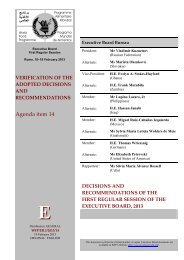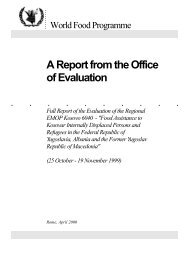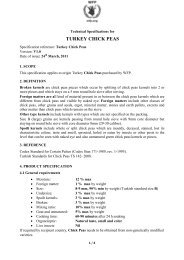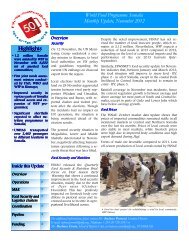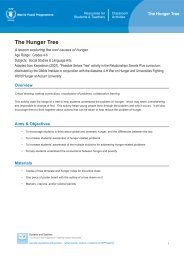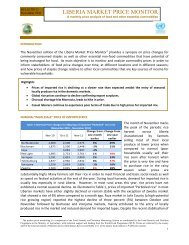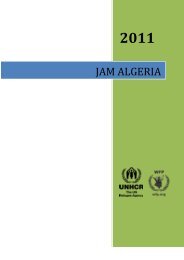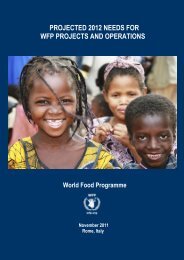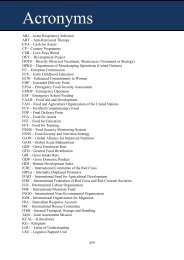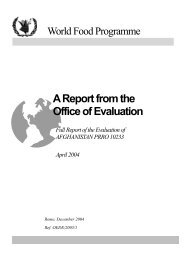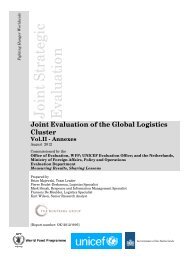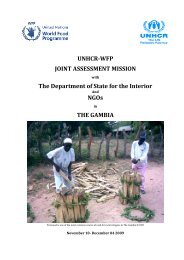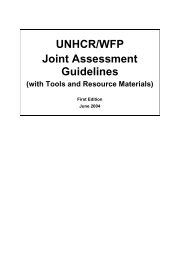The Potential for Scale and Sustainability in Weather Index Insurance
The Potential for Scale and Sustainability in Weather Index Insurance
The Potential for Scale and Sustainability in Weather Index Insurance
You also want an ePaper? Increase the reach of your titles
YUMPU automatically turns print PDFs into web optimized ePapers that Google loves.
THE POTENTIAL FOR SCALE AND SUSTAINABILITY IN WEATHER INDEX INSURANCE<br />
FOR AGRICULTURE AND RURAL LIVELIHOODS<br />
Box 3. Start-up <strong>and</strong> scal<strong>in</strong>g up of weather <strong>in</strong>dex-based <strong>in</strong>surance<br />
M<strong>in</strong>imum conditions <strong>for</strong> start-up<br />
• An enabl<strong>in</strong>g environment, <strong>in</strong>clud<strong>in</strong>g the effective legal <strong>and</strong> regulatory system to en<strong>for</strong>ce<br />
contracts <strong>and</strong> supervise <strong>in</strong>surance, <strong>and</strong> <strong>in</strong> which subsidized risk-management options do<br />
not crowd out market-driven products;<br />
• Adequate <strong>in</strong>frastructure (e.g. weather stations) to provide unbiased weather data <strong>and</strong><br />
m<strong>in</strong>imize basis risk;<br />
• Credible, cost-effective <strong>and</strong> commercially viable national <strong>in</strong>surers, whose payments are<br />
guaranteed by a credible authority, <strong>and</strong> <strong>in</strong>termediaries that market <strong>and</strong> package <strong>in</strong>surance with<br />
relevant <strong>in</strong>puts, technology, agronomic <strong>and</strong> weather <strong>in</strong><strong>for</strong>mation, <strong>and</strong>/or f<strong>in</strong>ancial services;<br />
• Coverage of the ‘right’ risks (i.e. <strong>in</strong>frequent, but high-impact events that threaten livelihoods<br />
or cause traditional cop<strong>in</strong>g mechanisms to fail), us<strong>in</strong>g an <strong>in</strong>dex that captures that risk well,<br />
m<strong>in</strong>imiz<strong>in</strong>g basis risk;<br />
• Availability of cost-effective products, <strong>for</strong> which clients f<strong>in</strong>d that the benefits of transferr<strong>in</strong>g<br />
risk are greater than the costs.<br />
Conditions <strong>for</strong> susta<strong>in</strong>ed scal<strong>in</strong>g up<br />
• Payouts that are based on objective, transparent, verifiable <strong>and</strong> underst<strong>and</strong>able criteria,<br />
<strong>and</strong> which reach clients soon after the <strong>in</strong>sured event;<br />
• Trusted, credible <strong>in</strong>termediaries <strong>and</strong> <strong>in</strong>surers;<br />
• Tangible coverage. People need to be able to relate to the expected benefits (payouts <strong>in</strong><br />
certa<strong>in</strong> cases) of the contractual relationship;<br />
• Transparency <strong>and</strong> underst<strong>and</strong><strong>in</strong>g. Farmers have a good underst<strong>and</strong><strong>in</strong>g of their risk<br />
exposure, <strong>and</strong> the function <strong>and</strong> benefits of a risk transfer <strong>in</strong>strument;<br />
• Adequate <strong>and</strong> susta<strong>in</strong>ed dem<strong>and</strong> <strong>for</strong> risk transfer products;<br />
• Af<strong>for</strong>dable, high-value products, <strong>and</strong> new ones over time as conditions evolve <strong>and</strong> farmers<br />
develop their bus<strong>in</strong>esses;<br />
• Smart subsidies <strong>for</strong> disaster-relief <strong>in</strong>surance products, m<strong>in</strong>imiz<strong>in</strong>g costs by adjust<strong>in</strong>g the<br />
target<strong>in</strong>g to match chang<strong>in</strong>g circumstances (i.e. the number <strong>and</strong> types of people who<br />
rema<strong>in</strong> vulnerable as the local economy develops). Any subsidies used to launch<br />
development <strong>in</strong>dex <strong>in</strong>surance products should be phased out over time;<br />
• Access to adequate re<strong>in</strong>surance arrangements to prevent <strong>in</strong>surers from default<strong>in</strong>g <strong>in</strong> years<br />
when large payouts are made.<br />
With development <strong>in</strong>dex <strong>in</strong>surance, products should catalyse access to credit <strong>and</strong><br />
other f<strong>in</strong>ancial services, technology or new markets, <strong>and</strong> they should help generate<br />
significant additional <strong>in</strong>come. <strong>The</strong>se value-added products, which complement<br />
exist<strong>in</strong>g risk-management strategies, can be attractive even without subsidies. <strong>The</strong><br />
additional <strong>in</strong>come created must be substantial, that is, it should be more than just<br />
enough to cover the <strong>in</strong>surance premium. Products must be af<strong>for</strong>dable <strong>and</strong> cover the<br />
most relevant risks with m<strong>in</strong>imal basis risk, <strong>and</strong> there must be opportunities to<br />
f<strong>in</strong>ance the premium (e.g. credit, sav<strong>in</strong>gs or other contractual arrangements with<br />
<strong>in</strong>put suppliers or agricultural producers <strong>in</strong> contract farm<strong>in</strong>g).<br />
37



